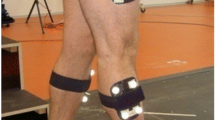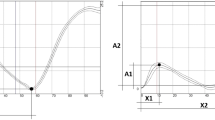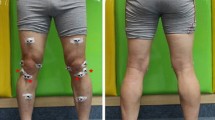Abstract
The purpose of this study was to assess dynamically the lateral thrust of anterior cruciate ligament (ACL) insufficient knees, and from the findings determine any relationship between ACL insufficiency and the later development of osteoarthritis (OA). We investigated 80 knees in 40 patients awaiting ACL reconstruction and 25 knees of 25 patients, which had undergone ACL reconstruction. An acceleration sensor was fixed to the anterior tibial tubercle and this ’acted’ in two directions – medial lateral and perpendicular. The peak value of the lateral acceleration immediately after heel strike was significantly greater in the ACL insufficient knees when compared to their opposite normal knees. When the periods from injury were compared, the lateral thrust of the injured side after 3 years or more was significantly greater than in the first 3 years. There was no significant difference between the normal knees and the ACL reconstructed knees. The results indicated that the lateral acceleration peak value was significantly greater in the ACL insufficient knees than in their opposite normal knees.
Résumé
A partir d’une évaluation dynamique de l’instabilité de genoux atteints d’insuffisance du ligament croisé antérieur (LCA), nous avons tenté de déterminer la relation entre l’apparition de l’arthrose du genou et l’insuffisance du LCA. Notre étude a porté sur 40 patients (80 genoux) devant subir une opération de reconstruction du LCA et 25 patients (25 genoux) après l’opération de reconstruction du LCA. Des détecteurs d’accélération ont été placé sur la tubérosité tibiale antérieure. Les pics d’accélération latérale suivant immédiatement le contact au sol du talon étaient significativement plus élevés chez les patients avec un genou atteint d’insuffisance du LCA que chez les patients normaux. Il est également apparu que les pics d’accélération latérale étaient significativement plus élevés dans les cas ou le délai après l’altération du LCA étaient de 3 ans ou plus que dans les cas ou cette période était inférieure à 3 ans. L’opération de reconstruction a permis une diminution significative des pics d’accélération au point que ceux-ci ne présentaient aucune différence significative avec ceux enregistrés avec les genoux normaux.
Similar content being viewed by others
Author information
Authors and Affiliations
Additional information
Accepted: 14 June 2000
Rights and permissions
About this article
Cite this article
Yoshimura, I., Naito, M., Hara, M. et al. Analysis of the significance of the measurement of acceleration with respect to lateral laxity of the anterior cruciate ligament insufficient knee. International Orthopaedics SICOT 24, 276–278 (2000). https://doi.org/10.1007/s002640000171
Issue Date:
DOI: https://doi.org/10.1007/s002640000171




